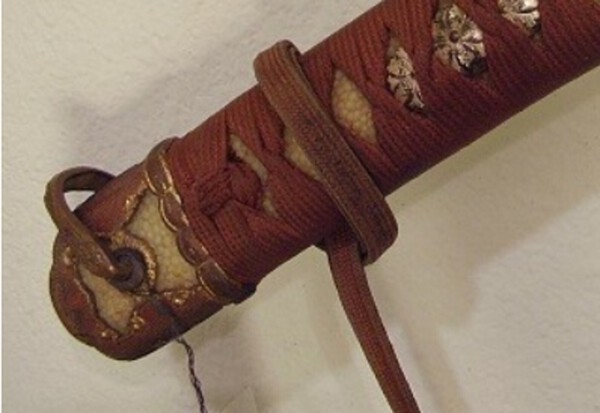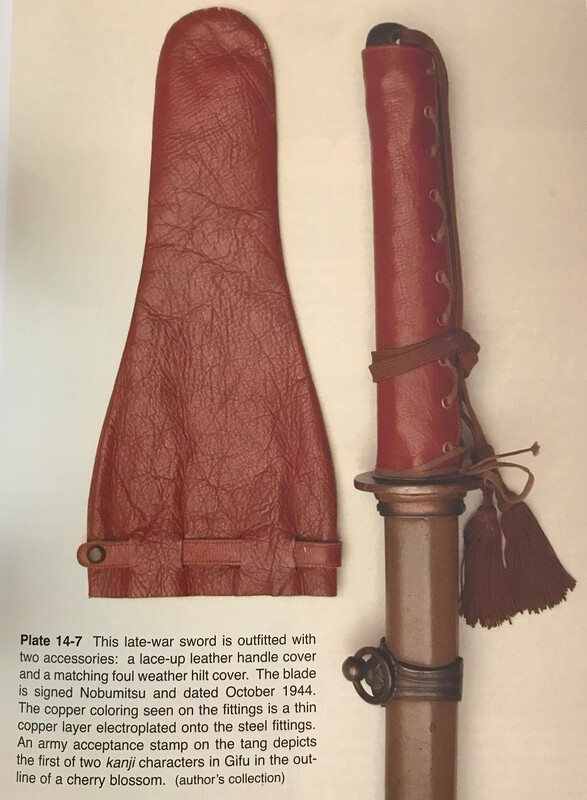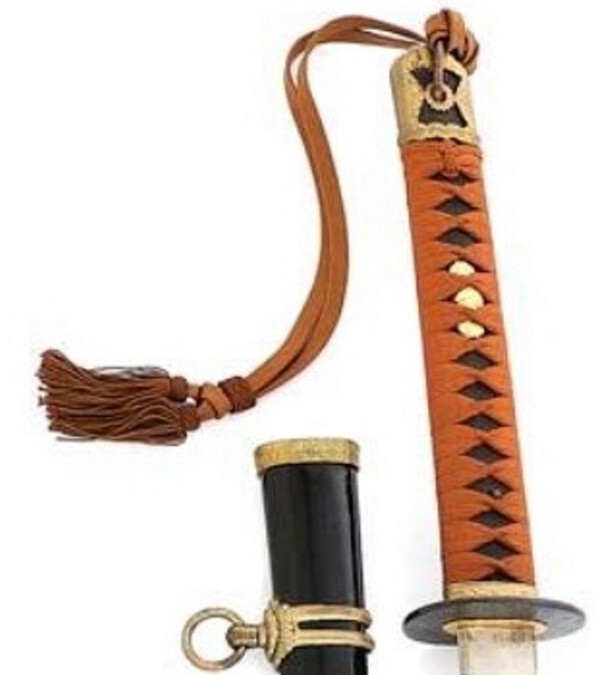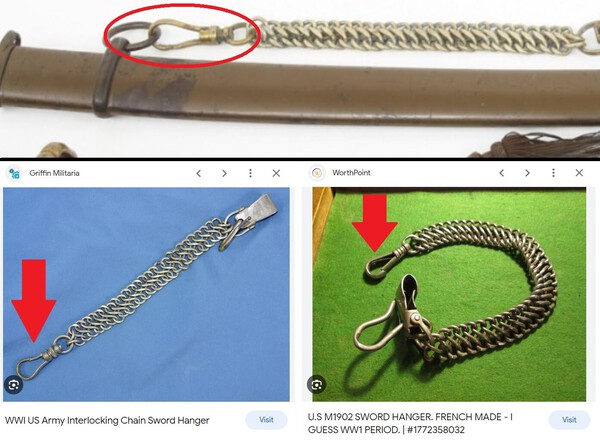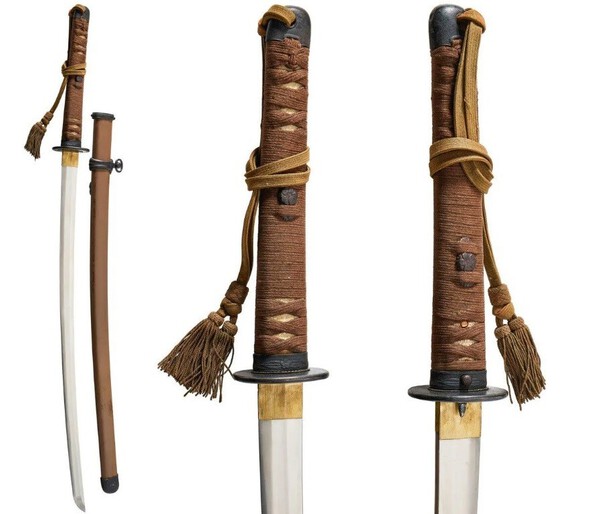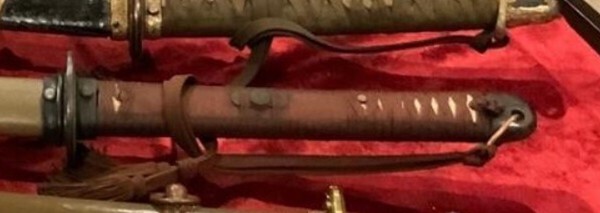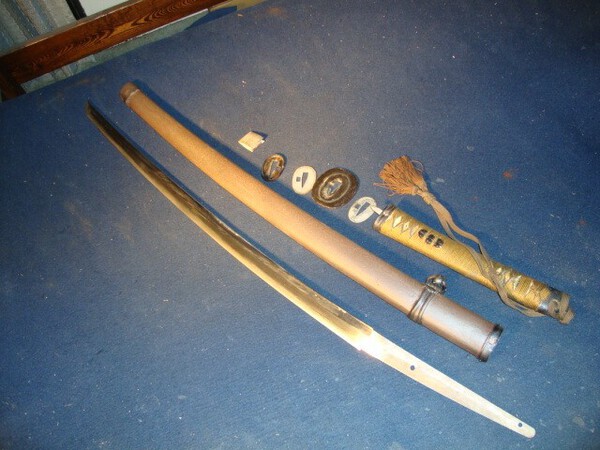
mdiddy
Dealers-
Posts
642 -
Joined
-
Last visited
-
Days Won
1
Content Type
Profiles
Forums
Events
Store
Downloads
Gallery
Everything posted by mdiddy
-
Breaking News On The All-Brown Army Gunto Tassel
mdiddy replied to Bruce Pennington's topic in Military Swords of Japan
Hmm, that's a tough one. I have been looking for conclusive evidence on the tassel, both sides of the cord, and/or the edges of the cord. I zoomed in on this one and the edges may be a little bit of a different color but it's not conclusive. Also we can't see the tassel or both sides of the cord. So, it's a toss-up in my mind, your call. -
Breaking News On The All-Brown Army Gunto Tassel
mdiddy replied to Bruce Pennington's topic in Military Swords of Japan
-
One more idea for consideration - the sword could have been shortened for usage in a kyu gunto type koshirae and then remounted later in WW2-era shin gunto koshirae. I say that because kyu gunto tsuka seem a little shorter and more restrictive than the shin gunto tsuka. The kyu gunto tsuka had the D-guard and narrower pommel to account for. My observation is that a lot of kyu gunto with older katana either had sue-koto katate-uchi style blades that featured shorter nakago by design or katana with suriage nakago. I recommend placing your translation request here. You will get a faster response if placed there.
-
Not necessarily. There are many examples of longer katana in gunto koshirae. For example, below is a picture of the well-known 36 inch odachi in gunto koshirae, purportedly carried by a general. If/when heirloom swords were cut down to fit gunto koshirae, it may have been a function of cost rather than specifications. A longer katana would probably require more customized mounts - longer saya, longer tsuka, etc - which the officer had to pay for. Though if they were a Japanese officer descending from a samurai family and had an heirloom katana, I want to assume they probably had a little more wealth than the average Joe. Maybe not all the time, but surely more often than not. Shortening a sword for gunto koshirae may also have been a function of practicality. Lugging around a 32 inch shinshinto beast through the jungle does not sound very practical.
-
Maybe some good news, but the Hozon paper makes no mention of the generation. It just confirms the mei as Chikuzen ju Minamoto Nobukuni Heishiro Yoshimasa. Regardless of the relativity of rankings, the rankings are higher for the nidai (2nd generation) vs. the sandai (3rd generation). The style of mei on your sword - kanji, chisel width, tagane, etc - is very similar to that of the nidai (2nd generation). I compared your mei to some others out there.
-
I am a fan of Chikuzen Nobukuni Yoshimasa. I have had several and keep one in my collection as it was an early find. If you google around for 'Nobukuni Yoshimasa' or 'Chikuzen Nobukuni Yoshimasa' you should find very many examples to compare to as well as good info on the Chikuzen Nobukuni school and his place in it. I wonder based on what you are saying if you are more likely to have an example by the 2nd generation Yoshimasa rather than the 3rd. The 2nd was very prolific and active in Kambun. The ratings you share align with the 2nd. You would probably be much more likely to run into a 2nd generation Yoshimasa than a 3rd. Would you have some pictures to share? Here are pictures of a couple. The katana is from my collection and shows a Soshu-style gunome midare with deep nioi guchi and prevalent sunagashi. The wakizashi I sold sometime back but shows a different type of gunome hamon. I also have a katana with a nice suguha, but no photos of it to share (yet).
-
Breaking News On The All-Brown Army Gunto Tassel
mdiddy replied to Bruce Pennington's topic in Military Swords of Japan
@Bruce Pennington Thanks for the updates and appreciate your inclusion of those two, the chart looks good! I found the one below that is interesting - a post-war souvenir with the brown tassel. Because it is post-war, it may or may not belong in the analysis. I wonder if the tassel on this one was added later to mimic a kai gunto tassel. -
Tips for finding inexpensive nihonto?
mdiddy replied to axeman1984's topic in General Nihonto Related Discussion
@axeman1984 If you are considering eBay, I recommend this seller: https://www.ebay.com/str/soheiantiques. Pretty sure you can get a good deal and he has very many swords not listed that could fit your need (for the record, this seller is me). Happy to help you find a good sword for a good price. I also recommend checking out some other dealers from the messageboard here who have lots of swords and can help (link is to their page on the message board and their introduction has contact info): 1. Mark Jones: https://www.militaria.co.za/nmb/forum/89-asian-arts-antiques-ltd/ 2. Grey Doffin: https://www.militaria.co.za/nmb/forum/120-Japanese-sword-books-tsuba/ 3. Matt Brice: https://www.militaria.co.za/nmb/forum/127-stcroixbladescom/ 4. Ray Singer: https://www.militaria.co.za/nmb/forum/121-swordsofjapancom/ -
Tips for finding inexpensive nihonto?
mdiddy replied to axeman1984's topic in General Nihonto Related Discussion
@axeman1984 Welcome to the forum! The most inexpensive and value-generating thing you can do would be to start by buying a few books. Not only will these be relatively cheap (probably < $100 for the first 3), but they will arm you with info that will help you save in the long run by avoiding costly mistakes. That said, the books are lot more interesting and fun to digest if you have a study aide to go along with them. I recommend trying to find a sword that is in as good a polish as your budget will allow so you can get the most out of studying key features like shape, hada, and hamon. Blades in good polish do not have to be terribly expensive. If you shop around, probably you could find a wakizashi, in good polish and in shirasaya in the $500-$700 range. Below $500 and you start getting into the realm of condition issues. -
Breaking News On The All-Brown Army Gunto Tassel
mdiddy replied to Bruce Pennington's topic in Military Swords of Japan
@Bruce Pennington Thanks for the clarification. Would you mind pointing out which two tassels you find concerning? -
Based on the pictures, yes polish looks feasible especially if the sword is ububa and never polished before. However, the devil is in the details, and pictures over the internet are able to rarely highlight nuances of forging and condition that may impact the polish. The effort should not be taken lightly. I recommend showing the sword in hand to polishers - even if it means back and forth shipping (a pittance of an expense compared to the cost of a polish). Letting polishers see the sword in hand will help you gather all the necessary info to make an informed decision. Looks like a nice sword. Good luck with it!
- 13 replies
-
- katana
- shin-shinto
-
(and 1 more)
Tagged with:
-
Breaking News On The All-Brown Army Gunto Tassel
mdiddy replied to Bruce Pennington's topic in Military Swords of Japan
@Ian B3HR2UH Yes, agreed, and thanks for the contribution Ian! One small clarification - my name is Matt, not Bruce. Regardless of the striking resemblance, Bruce and I are actually not the same person. I take it as a compliment to be mixed up as him though, haha!! J/K Anyway, just a small clarification, we did business in the past but it has admittedly been awhile -
Breaking News On The All-Brown Army Gunto Tassel
mdiddy replied to Bruce Pennington's topic in Military Swords of Japan
Thanks Trystan for sharing your findings. One of the critiques of this entire analysis we are all contributing to will eventually be that there is little evidence to prove the tassels were not added later or swapped around after the war. As I have been researching, if there were any obvious signs a tassel may have been added later I discarded the result. For the second NCO shown, the hanger looks to be that of an American M1902 saber. It's surely open for debate, but that kind of suggests the accoutrements on this NCO might have been added later to help with its sale. That would probably make a little more sense in the context of things. Anyway, just wanted to highlight it. -
Breaking News On The All-Brown Army Gunto Tassel
mdiddy replied to Bruce Pennington's topic in Military Swords of Japan
@Bruce Pennington Thanks for sharing this. I think there are a couple examples missing. I'm counting I provided 15 late war guntos and your tally is only showing 13. Would you mind re-checking? I can probably get more sources than just Mdiddy, NMB. Would that be helpful? -
Breaking News On The All-Brown Army Gunto Tassel
mdiddy replied to Bruce Pennington's topic in Military Swords of Japan
@Bruce Pennington Thanks for your continued tracking of the data! Would you be able to share an updated chart with all of the recent additions? Might be good for a quick refresh. -
Looks like a nice buy to my eye. Good strong shape, signed, in polish, fully mounted - I'd say you had a pretty good show!
-
Great topic! I always found these photos of Yamashita's initial contact and surrender really cool. They are from Fred Lohman's site here and he obtained them from the servicemen that took the photos. I wish the photos were larger but it looks like the links to larger photos are now broken from the site.
-
I agree with Mark. Looks like a Seki-made showato.
-
Breaking News On The All-Brown Army Gunto Tassel
mdiddy replied to Bruce Pennington's topic in Military Swords of Japan
-
Breaking News On The All-Brown Army Gunto Tassel
mdiddy replied to Bruce Pennington's topic in Military Swords of Japan
-
Breaking News On The All-Brown Army Gunto Tassel
mdiddy replied to Bruce Pennington's topic in Military Swords of Japan
This one looks entirely brown to my eye. Even if faded, a blue shade would be consistently seen, particularly around the seams as well as mixed in the tassels and I don't see either here. What I do see though are potential stains, inconsistently distributed, which is a very common occurrence on tassels. -
Breaking News On The All-Brown Army Gunto Tassel
mdiddy replied to Bruce Pennington's topic in Military Swords of Japan
-
Breaking News On The All-Brown Army Gunto Tassel
mdiddy replied to Bruce Pennington's topic in Military Swords of Japan
-
I don't think that's correct. I don't see how the circled character can be read as michi 道. It is nao 直. I recommend not assuming that because someone else said it on the internet that it is correct. I think this swordsmith is Ishihara Kanenao 石原 金直. He is listed in Dr. Kim's translated list of Seki Tosho. The list also includes Kinmichi but it is 金道, not 金直. The list of Seki Tosho also includes another documented Takayama-to swordsmith Hattori Masahiro. Also another documented Takayama-to swordsmith signed Ishihara Masanao 石原正直. Probably Ishihara Kanenao is same or related to the other Takayama-to swordsmith Ishihara Masanao. I am not aware of there being a Takayama-to swordsmith Kinmichi.

